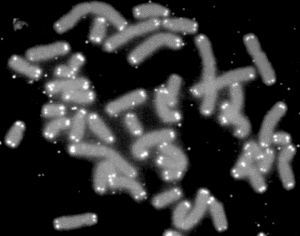
Chromosomes tipped by telomeres.
A study published recently in Science by Susanne Horn and colleagues is a noteworthy example of hypothesis-driven science done right. It exemplifies how seemingly obscure findings can lead to new hypotheses and provide insight into human health and disease.
Horn and her colleagues studied a family prone to melanoma and other cancers and found a mutation located near the TERT gene in a region that controls the gene. Researchers have long been interested in this gene because it encodes a protein called telomerase that is important for both aging and cancer.
The telomerase protein protects telomeres, the “caps” at the ends of chromosomes. Telomeres have been likened to the plastic tips on shoelaces because they stop the ends of chromosomes from coming apart and are critical for a healthy cell. Telomeres become shorter each time a cell makes a copy of itself and thus get shorter with age. Since the telomerase protein adds DNA back onto the telomere each time the cell divides, numerous researchers have studied it in the interest of prolonging human life. But others have cautioned that too much telomerase activity might contribute to cancer.
Horn looked to see if more people with melanoma also had the mutation discovered in the family but were unable to detect it in individual cases of melanoma, in other families with melanoma, or in large genetic databases. It seemed to be a genetic one-off, a mutation isolated to this one family.
Realizing that this unique mutation might provide insight into a mechanism of cancer, the researchers next looked at DNA from melanoma tumors and found very similar mutations. The mutations in the tumors were not present in the person’s DNA at birth but rather arose during his or her lifetime. By analyzing the mutations very closely the researchers concluded that both the mutation found in the family and those found in the tumors contribute to cancer through a similar mechanism.
Both types of mutations influence the regulation of the TERT gene and result in increased levels of the telomerase protein. Normally telomerase is not active in adult cells that aren’t dividing — for instance cells in the skin, heart and other places. In people with these mutations, more telomerase likely leads to longer telomeres, more dividing cells and ultimately cancer. Though scientists have also cautioned that it might not be this simple and that too much telomerase protein could also promote cancer through other mechanisms.



